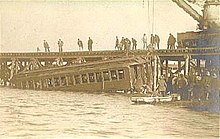Atlantic City Railroad Accident (1906)
In the 1906 Atlantic City railroad accident on October 28, 1906, a train derailed on a drawbridge in Atlantic City , New Jersey , due to a technical fault in the bridge . The train fell off the bridge. 53 people drowned.
initial situation
The accident occurred on a recently electrified railway line of the West Jersey and Seashore Railroad , a subsidiary of the Pennsylvania Railroad , shortly before the entrance to the Atlantic City train station. The railway line crossed a body of water on a drawbridge, called " The Thoroughfare ", which was about 10 meters deep there.
The bridge over the water was checked for functionality after electrification and was not put into operation until the same day. It was secured on both sides by signals that only showed "clear to move" when the bridge was in a horizontal position. A train heading west had already passed through it without interference.
A three-part electric multiple unit from Camden with 87 passengers drove towards the bridge from the west at around 2:20 pm . The powered unit pushed the train. As usual, the doors of the cars were locked.
the accident
The bridge had been opened briefly to shipping to allow a boat to pass and then leveled again so that the Camden train could pass through it. This drove onto the bridge at a speed of around 60 km / h. Contrary to the signaling, the bridge had not closed completely, and the eastern drawbridge segment still protruded slightly over the western one. As a result, the train derailed , slid about 50 meters over the thresholds and then fell 5 meters into " The Thoroughfare ". The first two wagons fell straight into the water, the pushing wagon got caught in the substructure of the bridge and hung there for a short time. Since the doors were locked, it was difficult for the trapped passengers to leave the car. A brakeman in the last car immediately unlocked one of the rear doors of that car and held it open. A number of passengers escaped here, while in the first two cars only one or two people survived and everyone else drowned.
examination
The investigation revealed that the first train, coming from the east, had pushed the slightly upward bridge segment, onto which it drove normally on the land side, into the correct position due to its weight at the contact point with the western folding segment and therefore the bridge without it Problems could happen. The train from Camden, on the other hand, had hit the high eastern bridge segment and therefore derailed.
The examination of the signal system showed that it only reacted to the horizontal position of the bridge segments, but no controls were integrated to ensure that they were really flush with one another.
consequences
A consequence of the accident was the first press release . The public relations expert Ivy Lee , who worked for the Pennsylvania Railroad , aggressively persuaded them to approach the newspaper representatives at the accident site with a press release. The New York Times printed the press release verbatim on October 30, 1906.
See also
literature
- Anthony J. Bianculli: Iron Rails in the Garden State: tales of New Jersey railroading . Indiana University Press. Bloomington 2008. ISBN 978-0-253-35174-6 , pp. 125ff.
- Edgar A. Haine: Railroad Wrecks . 1993. ISBN 0-8453-4844-2 , pp. 68f.
- PRR Atlantic City Wreck
- Robert C. Reed: Train Wrecks: A Pictorial History of Accidents on the Main Line . New York 1968. ISBN 0-517-32897-6 , pp. 90, 100.
- St John Sun v. October 29, 1906 ( digitized in: news.google.com )
Individual evidence
- ↑ The New York Times v. October 29, 1906 ( Memento of the original from March 12, 2012 in the Internet Archive ) Info: The archive link was inserted automatically and has not yet been checked. Please check the original and archive link according to the instructions and then remove this notice. .
- ↑ Press release of the Pennsylvania Railroad ( page no longer available , search in web archives ) Info: The link was automatically marked as defective. Please check the link according to the instructions and then remove this notice. .
Coordinates: 39 ° 21 '52.2 " N , 74 ° 26' 44.3" W.
